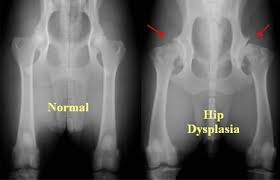Hip dysplasia (HD) refers to the malformation of the hip joint: instead of a round femoral head fitting smoothly into a deep acetabulum, the joint contains a shallow socket and irregularly shaped ball. These malformations cause uneven contact between the joint surfaces compromising the joint stability and eventually deforming the bone and causing pain.

This laxity in the joint also erodes the joint and causes inflammation and bone remodeling to occur, which in turn leads to arthritis or degenerative joint disease. HD can be unilateral or bilateral. A vast majority of dogs with hip dysplasia can lead active lives with non-surgical therapy but for others it can result in pain and discomfort with the hip joint gradually deteriorating and leading to loss of function. Owners should be aware of the signs of pain that are more likely to develop with the condition and to take action when necessary.
Causes:
The cause of hip dysplasia is usually genetic, but environmental factors can contribute. Dogs can develop HD when they are young and physically immature as their bones are still soft and so can very easily become malformed with activities of daily living. Early onset usually develops after four months of age in their initial growth phase (up to 2 years). However a later onset can occur if arthritis in the joint has caused the hip dysplasia.
Sports injury or inappropriate exercising routine, causing muscle imbalances during the puppy’s crucial developmental can cause unilateral hip dysplasia.
Monitor these activities to keep young hips safe and healthy:
Jumping in/off out of the car, sofa or bed |
Starting sports too early (e.g. getting a puppy to jump full height at agility |
Living on laminate / wooden / slippery flooring |
Going up / down stairs |
Either over or under exercising |
Nutrition |
Signs/Symptoms:
Difficulty rising |
Bunny hopping |
Stiffness |
Decreased range of motion |
Licking or nibbling at fingers while touching the hips |
Reluctant to run, jump or climb stairs |
Back legs closer together VS the front legs |
Enlargement of the shoulder muscles |
Exercise intolerance |
Joint laxity |
Sitting in a “frog” position |
Swayed gait |
Animal Massage could help:
Relieve soreness and stiffness |
Correct muscle balance and posture |
Enable the dog to enjoy exercise |
Assist in pain relief |
Reduce inflammation |
Relieve tension |
Develop and maintain muscle tone |
Help strengthen muscle |
Lymphatic drainage |
Visit our website at today at www.easeanimalmassage.com for more information and to schedule a FREE consultation today.

